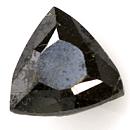|
|
||||||||||||||||
|
||||||||||||||||
|
||||||
|
|
|
|
Perovskite
|
|
| | |
| Discovered in 1839; IMA status: Valid (pre-IMA; Grandfathered) | ||
|
| ||
|
Chemistry |
|
|
| |
|
CaTiO3 | |
|
|
Calcium Titanium Oxide |
|
Molecular Weight: |
135.96 gm |
|
Composition: |
Calcium |
29.48 % |
Ca |
41.25 % |
CaO |
|
|
Titanium |
35.22 % |
Ti |
58.75 % |
TiO2 |
|
|
Oxygen |
35.30 % |
O |
|
|
|
|
|
100.00 % |
|
100.00 % |
= TOTAL OXIDE |
|
|
|
||||
|
Classification |
|
|
| |
|
Oxides | |
|
4/C.10-20 | |
|
|
4 : OXIDES (Hydroxides, V[5,6] vanadates, arsenites, antimonites, bismuthites, sulfites, selenites, tellurites, iodates) |
|
Related to: |
Perovskite Group. The Ti analogue of Lakargiite. Isostructural with Lakargiite. |
|
Varieties: |
Dysanalyte, Knopite |
|
Synonyms: |
Metaperovskite, Perofskite, Perovskite (of Rose), Uhligite (of Hauser) |
|
|
|
|
Crystal Data |
|
|
|
|
|
Commonly resemble distorted cubes, to 12 cm, striated || [001] and [110], rarely cubo-octahedra or octahedra, with additional forms, skeletal, dendritic; reniform, granular massive. |
|
|
90º and 180º about [101], rarely 180 about [121], giving complex penetration twins; lamellar and sectored. |
|
|
|
|
|
Physical Properties |
|
|
|
|
|
Imperfect/Fair on {001} |
|
|
Irregular/Uneven to Sub-Conchoidal |
|
|
Brittle |
|
|
5.5 |
|
|
3.98 - 4.26 (g/cm3) |
|
|
None |
|
|
Not Radioactive |
|
|
|
|
|
Optical Properties |
|
|
|
|
|
Iron-Black, Brown, Reddish Brown to Yellow; Colorless to dark Brown in transmitted light; dark Bluish Gray in reflected light. |
|
|
Opaque, Transparent in thin fragments |
|
|
Adamantine, Metallic, Sub-Metallic, may be Dull |
|
|
2.300 - 2.380 Biaxial ( + ); commonly Isotropic |
|
|
0.080; commonly Isotropic |
|
|
r > v; n = 2.34–2.37 |
|
|
Weak; Z greater than X |
|
|
Color in reflected light: dark Bluish Gray |
|
|
|
|
|
Occurances |
|
|
|
|
|
Geological Setting: |
An accessory mineral in alkaline mafic rocks, as nepheline syenites, kimberlites, carbonatites, commonly deuteric; in calcareous skarns. A common accessory in Ca–Al-rich inclusions in some carbonaceous chondrites. |
|
Common Associations: |
Akermanite–Gehlenite, Nepheline, Titanite, Ilmenite, Magnetite. |
|
Common Impurities: |
Fe, Nb, Ce, La, TR |
|
Type Locality: |
Akhmatovskaya Kop' (Achmatovsk Mine), Nazyamskie Mts, Zlatoust, Chelyabinsk Oblast', Southern Urals, Urals Region, Russia |
|
Year Discovered: |
1839 |
|
View mineral photos: | |
|
|
|
|
More Information |
|
|
|
|
|
| |
|
|
|
|
Perovskite is an increasingly economically important mineral that is sought after for its rare earth metal content. Often Perovskite is enriched in cerium, niobium, thorium, lanthanum, neodymium and other rare earth metals. Rare earth metals are becoming rather attractive for prospectors due to their growing value to industry. The titanium derived from perovskite is recovered as well. Perovskite crystals appear as cubes, but this is deceiving because it is actually pseudocubic (or "falsely shaped" in a loose translation from the Greek). It is really orthorhombic in symmetry, but its structure is very close to isometric. Perovskite crystal specimens may look like darkly colored Galena cubes, but Galena has better metallic luster, greater density and perfect cleavage. There
are many localities for Perovskite. Large crystals at
the Akhmatovsk mines, near Zlatoust, Ural Mountains,
and from the Lovozero massif, Kola Peninsula, Russia.
At Norrvik, and on Aln¨o Island, Sweden. From Zermatt,
Valais, Switzerland. At Schelingen and Vogtsberg, Kaiserstuhl,
Baden-W¨urttemberg; Oberwiesenthal, Saxony; and in the
Eifel district, Germany. In Italy, from St. Ambrogio
and the Val di Susa, Piedmont, and in the Val Malenco,
Lombardy. At the Jacupiranga mine, S˜ao Paulo, Brazil.
Large crystals from the Gardiner complex, beyond the
head of Kangerdlugssuaq Fjord, Greenland. At Oka, Quebec,
Canada. In the USA, from the Crestmore quarry, Riverside
County, and near the Gem mine, San Benito County, California;
in a large deposit in the Iron Hill carbonatite, Gunnison
County, Colorado; at Magnet Cove, Hot Spring County,
Arkansas. |
|
|
We
have not photographed our Perovskite gems. Please
check back soon. |
